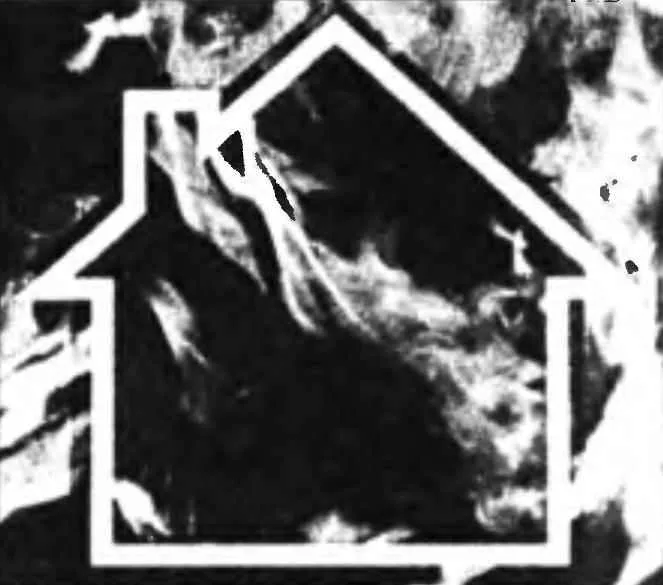 Building a country house, we try to protect it from the damaging effects of fire: use heat-resistant materials, buy fire extinguishers, installed fire alarm. But the protection from lightning often forget.
Building a country house, we try to protect it from the damaging effects of fire: use heat-resistant materials, buy fire extinguishers, installed fire alarm. But the protection from lightning often forget.
One of the possible reasons for the neglect of our countrymen to this question is that building regulations do not consider mandatory lightning protection of buildings with a height less than 30 m. in addition, many people used to hope for the best convincing myself that the likelihood of an electrical discharge in their vacation home is almost zero.
 However, lightning can inflict very serious damage even if it hits a few dozen meters from the home. In addition to the serious danger to people and fire in residential and utility rooms, it is also the scrapping of expensive computers, CCTV systems, utilities, etc.
However, lightning can inflict very serious damage even if it hits a few dozen meters from the home. In addition to the serious danger to people and fire in residential and utility rooms, it is also the scrapping of expensive computers, CCTV systems, utilities, etc.
From 5 to 20 thousand thunderstorms are raging daily in the world. Meanwhile to protect your home and yourself from such unpredictable natural phenomena is quite real — it is sufficient to use a special engineering system of the lightning rod and properly install it. And then no storm will not be afraid.
Therefore, the most advanced gardeners, the owners prefer not to risk it and establish a protective system external (to protect the building from lightning strike) and internal (in order to protect areas of the house from the secondary effects of electrical discharge). External protection, in turn, is divided into classic and active. Each variety has its own characteristics that must be considered in the construction of individual homes or villas means lightning safety.
Time-tested
 Other classical names of external lightning protection systems open in the eighteenth century American statesman Benjamin Franklin, — passive and mechanical. It consists of three interconnected elements: the lightning arrestors and grounding.
Other classical names of external lightning protection systems open in the eighteenth century American statesman Benjamin Franklin, — passive and mechanical. It consists of three interconnected elements: the lightning arrestors and grounding.
Lightning (or lightning rod) that receives the electric shock, do in the form of a cable on the roof or mesh, making the building, but most often in the form of a steel pin or rod with a diameter of about 12 mm and a length of 0.2 — 1.5 m. It is installed on insulators and fixed to the highest point of the roof.
Lightning rod is easy to make your own from steel rod or tube. If the part is hollow its end necessarily need to brew, otherwise the lightning will be inside the cylinder and trigger the ignition of the roof.
It is best to think over the design molniezaschita system simultaneously with the design of the house — before its construction. This will allow to avoid many errors and technological issues often associated with mounting fixtures on the already erected building.
Lightning is welded to the current collector (descent) — the conductor of round or flat steel with corrosion-resistant zinc coating. The connection must withstand up to about 200 kA. Then, the current collector is lowered from the roof, attaching to the wall of the building insulated metal straps.
The other end is firmly welded with the grounding metal rod, trim profile, sheet, pipe or the whole system of angles, bars and channels, which are buried in the ground to a depth of 2 — 3 m and neutralize the electrical discharge. The collector it is best to lay on the back wall of the building, and the ground is to dig away from the Foundation of the house and outbuildings.
The main advantages of the classical version of the lightning — reliability and affordable price feasible for the majority of owners of country real estate. The disadvantage is not too attractive appearance: the steel reinforcement does not fit well into the architectural appearance of the building.
In the activity zone
Relatively new for our country the system of external lightning protection has already received recognition of experts and has attracted the attention of consumers. From the classic it is more coverage, due to another principle of the lightning rod. This item is not idle. expecting a direct lightning strike, and is constantly working — ionizes the air space around itself, thus forming a vast area of active protection. The result is lightning an electric discharge that occurred anywhere this zone will be attracted to the antenna receiver on the roof, will pass through the collector, and securely grounded.
Pros: this system is able to protect from lightning of buildings a considerable area, are characterized by high reliability, durability and environmental friendliness. In addition, their lightning is compact and does not spoil the appearance of the building. But active devices have one major drawback — high price. Therefore the installation can not afford it.
Internal control
 It is equally important to take care of the installation of the system of internal lightning protection of the cottage or Villa is the equipment protecting the home contents from the secondary manifestations of the storm: dangerous effects of electromagnetic fields and voltage drops in electric network, able to seriously damage the wires, the utilities building and modern equipment (computers, audio and video players, television receivers, video surveillance or burglar alarms, heating and air-conditioning).
It is equally important to take care of the installation of the system of internal lightning protection of the cottage or Villa is the equipment protecting the home contents from the secondary manifestations of the storm: dangerous effects of electromagnetic fields and voltage drops in electric network, able to seriously damage the wires, the utilities building and modern equipment (computers, audio and video players, television receivers, video surveillance or burglar alarms, heating and air-conditioning).
The composition of such systems include surge-or lightning protectors installed in the house at a special introductory switchboard. They are based on semiconductor resistors that change their resistance depending on the applied voltage to them and with his leap in a moment of lightning completely burn out (after which they just replaced). In addition there are disposable and reusable more expensive limiters, self-healing after discharge.
The elements of the internal system also include device surge protection (SPD). They protect expensive home appliances from the ravages of the induced voltage caused by the storm.
In addition, the internal lightning protection allows you to equalize the potentials of individual consumers. For all of the current collectors connected to one grounding strip, otherwise the induced voltage itself will seek to do the same, but irreversible for household appliances consequences.
Select the “shield”
 Today in the domestic market a large choice of different molniezaschita systems. How do you know which system is best for a particular garden or cottage?
Today in the domestic market a large choice of different molniezaschita systems. How do you know which system is best for a particular garden or cottage?
First, it is necessary to proceed from the location of the building and surrounding environmental conditions. If the house, for example, is in the forest, in the valley where the lightning strikes is rare, it is possible to do a simplified version of protection — for example, to install a lightning rod on the tallest tree, growing near. It will take the brunt during a thunderstorm, and a collector with the ground would negate the risk of fire. If the structure is in an open elevated location, to save on the lightning protection is impossible — it makes sense to install both internal and external (better active) system.
Installation molniezaschita system — very laborious and responsible job that requires preliminary calculations and design. Therefore, it is necessary to consult with experts, to listen to their recommendations. Otherwise, if you take the case yourself without the proper knowledge, assembled equipment will not only protect the house during a lightning storm, but will become a potential source of danger.
When srednekraevoy “activities” more than 20 hours a year (in the middle lane, it varies from 20 to 80 hours), you must arrange lightning protection. Lightning protection system consists of lightning arrestors and grounding. Lightning takes a direct lightning strike and shall withstand thermal and dynamic loads. For these purposes it is possible to use flat and round steel. The smallest section of the lightning 60 mm2 with a length of at least 200 mm.
 For the collector used galvanized round steel wire of diameter not less than 5 — 6 mm. With lightning it is connected by welding, soldering, riveting, bolting, and with the ground only by welding or soldering with hard solder. The contact area shall be not less than twice the sectional area of the abutting parts. The current collector paving the shortest way in the places most likely a lightning strike (roof ridges, ledges and edges of the gable). They attach staples, clips, nails. When legkovozvodimyh the roof they must defend it from 150 to 200 mm.
For the collector used galvanized round steel wire of diameter not less than 5 — 6 mm. With lightning it is connected by welding, soldering, riveting, bolting, and with the ground only by welding or soldering with hard solder. The contact area shall be not less than twice the sectional area of the abutting parts. The current collector paving the shortest way in the places most likely a lightning strike (roof ridges, ledges and edges of the gable). They attach staples, clips, nails. When legkovozvodimyh the roof they must defend it from 150 to 200 mm.
The grounding, which serves to dissipate lightning current into the ground must have a low electrical resistance. It is placed at a distance of not less than 5 m from the porch, and pedestrian walkways. In dry soils and low water arrange vertical wires in the form of two rods with a length of 2 — 3 m driven into the ground at a distance of 3 m from each other and connected by an underground bridge section of 100 mm2 at a depth of not less than 0.5 m. the current Collector is attached to the middle of the jumper all connections are made by welding.
In wet soils and the altitude of groundwater less than 1.5 m (and also on the moor) make a horizontal grounding. It is laid to a depth of at least 0.8 m of metal pipes, angles, sheets, etc. as the earthing may be the end of the current collector laid at a depth of at least 1 m longer Than its length in the ground, the more reliable will be working lightning protection.
Internal and external lightning protection must be grounded separately from each other. In houses with non-metal roof lightning protection can be arranged in the form of stretched along the ridge of the roof of the steel wire from the lightning – mi. Wire stretched between wooden posts at a height of 250 mm from the ridge. The rack is attached to the Gables.
For the equipment of external lightning protection can be used standing next to the tall trees. Lightning protection is performed in this case from a single piece of wire with a diameter of 5 — 8 mm, with a unilateral its descent and ground in the form of a loop. In this case, the core area of lightning protection is determined on the ground level with a radius of R = 1.51 level. (where I. the height of the lightning rod).
Lightning protection systems should be periodically checked to verify the reliability of the connections.
Valid options
 All external lightning arresters, despite some differences in design, consist of supports, lightning arrestors and grounding. The lightning typically use rod and cable. The lightning rod is made from round steel with a diameter of 12 mm square 10×10 mm, or from water-gas supply pipes. The minimum cross-sectional area takogogo lightning should be at least 100 mm2, length — 200 — 1500 mm. When using pipes, the upper end of their tightly brewed, crushed or closed by a metal stopper, and to avoid rust, they are painted with oil paint.
All external lightning arresters, despite some differences in design, consist of supports, lightning arrestors and grounding. The lightning typically use rod and cable. The lightning rod is made from round steel with a diameter of 12 mm square 10×10 mm, or from water-gas supply pipes. The minimum cross-sectional area takogogo lightning should be at least 100 mm2, length — 200 — 1500 mm. When using pipes, the upper end of their tightly brewed, crushed or closed by a metal stopper, and to avoid rust, they are painted with oil paint.
Lightning rope is a steel rope marks according to GOST 3063-55 with the cross-sectional area of 48.2 mm2. A metal cable with bearing structure lightning protection system or a separate collector connected spot clamp type PS-2A.
The electrodes connection of lightning with ground — usually made of steel with a cross sectional area not less than 35 mm2 stranded or wire rope of the same diameter.
The electrodes carried by the shortest route with the largest possible distance from the wiring. All joints of current-carrying elements shall be performed by welding. Weld contact area must be at least twice the cross-sectional area of the collector.
Under grids you can use your existing metal building construction: fire stairs, frame, rebar reinforced concrete elements. Spruce, pine, deciduous and fir support comfortable under a lightning rod. Use close standing in front of the wood under cable lightning rods impractical.
The electrodes are laid directly on the walls and roofs of the building with the largest possible distance from the wiring; the ends are grounded in inaccessible places.
Pillars of lightning rods can be made of wood, concrete and metal.
Timber supports used as a lightning rod type. The backbone of the lightning protection system can be remotely located from the home tree. For mounting in this case, use branches and rough trunk. The height of the lightning rod on a tree further increase, attach to the tree pole with lightning and the collector.
Earthing switches are vertical (in the form embedded in the earth rods), horizontal (in the form of rays or rings of steel strips) and combined.
Length of vertical earth rods — 2 — 3 m, their score is in the pits with a depth of 0.7 — 0.8 m, then the hole covered. Horizontal grounding conductor placed at a depth of 0.6 — 0.8 m Under the simplified lightning protection grounding use of round steel with a diameter of 5 — 6 mm for the largest grounding lightning protection system can be used round steel with a diameter of 15 — 20 mm, steel pipe with outer diameter 30 — 60 mm and wall thickness not less than 3.5 mm and strip steel with a width of 20 to 40 mm and a thickness of 4 mm, angle steel No. 4 — 6, etc. to Cover the elements of ground varnish or bitumen, are prohibited. Combine them into a single grounding system only by welding. As a rule, earthing switches are placed outside the building at a distance of 0.8 — 1 m from the Foundation.
The metal roof of the house itself may perform the role of lightning, while near the chimneys and vents install a separate protecting their members.
For the protection of chimneys, arrange the lightning conductor of steel wire with a diameter of 5 mm, which is attached to the pipe with the help of “forks” of the same wire.
Onoznaczenia:
Lightning protection system laid down when building a house:
1—lightning rod;
2—lightning cable;
3—Toko-taps;
4—jumper shunts (buried);
5—earthing switch (recessed metal core).
Lightning protection on the roof:
1—lightning rod;
2—grids.
External lightning rod
(A—pillar, B—on a wooden mast):
1 —lightning rod;
2—electrodes;
3—the earth.



